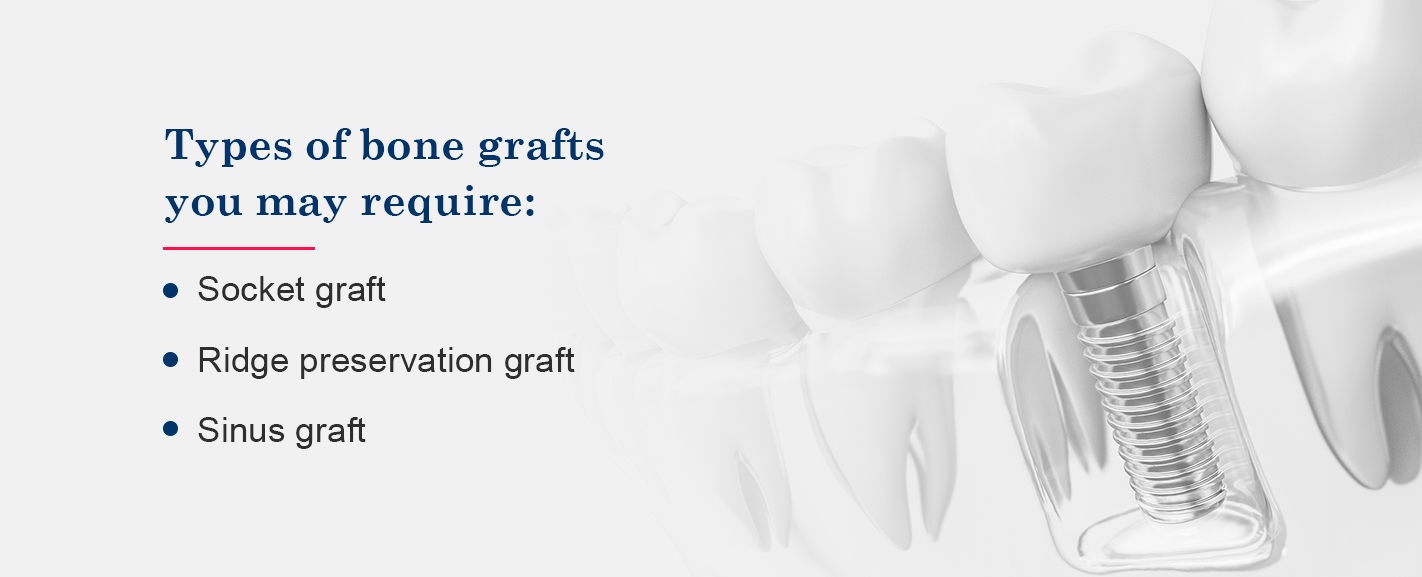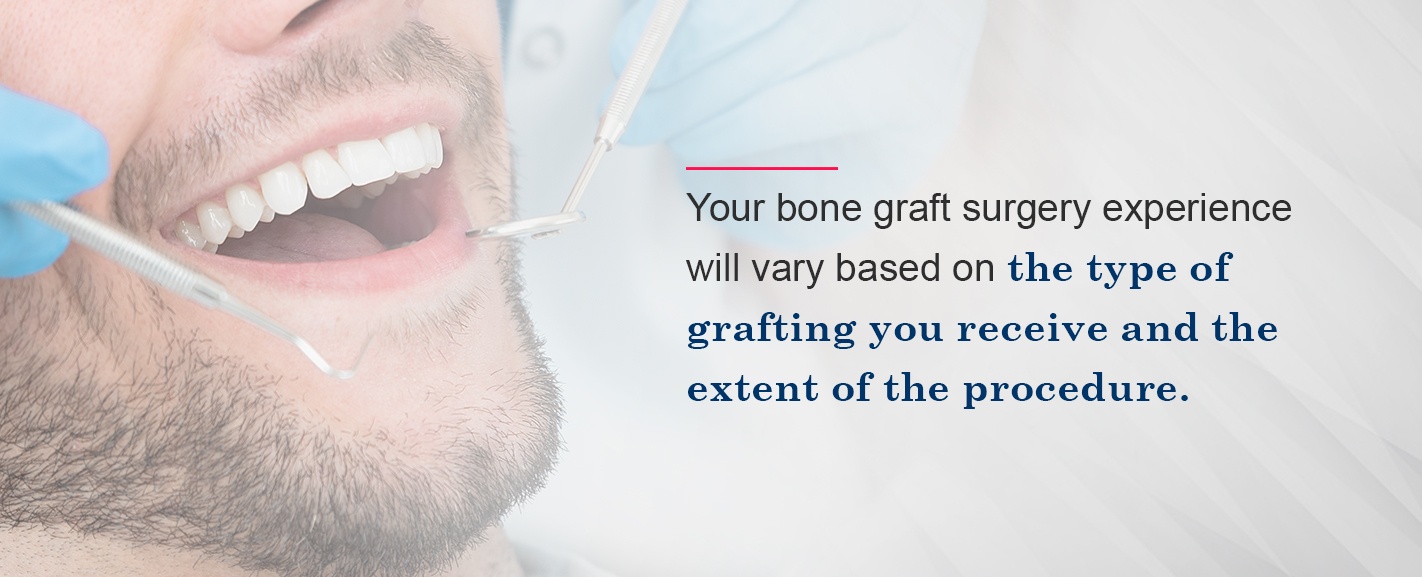dental graft what is the best kind of bone to use
Dental Bone Graft & Regeneration – Need To Know
Feb 7, 2020

What to Know Nearly Dental Os Regeneration and Grafting
If yous're because dental implants, you know yous demand a long-lasting artificial molar solution. What you may not realize is that bone regeneration could be function of your process toward dental implants. Most dental implants are inserted directly into the jawbone to function like a natural tooth's roots. This structure provides a solid foundation for the implant and allows yous to use the replacement tooth like you would natural teeth.
Factors like oral health and the length of fourth dimension you've been missing a tooth can weaken and thin the jaw. Bone grafting — also known as bone regeneration— is completed in situations when a patient's jawbone cannot properly support a dental implant. Os graft procedures provide an excellent opportunity to strengthen a jaw dorsum to the point where information technology can properly back up a dental implant. This could let many patients, including you, to enjoy the benefits of dental implants and restored oral health.
What Is Bone Regeneration?
Bone regeneration is a process that uses other bone as a scaffold to grow new bone in weak jawbone areas. This is necessary considering in one case y'all no longer take tooth roots securing a portion of your jaw, that os volition begin to deteriorate. Depending on the type of os graft, you can expect one or more grafting procedures, a short recovery period and a longer healing period.

Based on your state of affairs, there are iii dissimilar types of os grafts you may require:
- Socket graft:A socket graft typically occurs after a patient has a tooth extracted. The procedure seeks to repair or protect the socket that remains after the extraction. Bone fabric is typically inserted direct into the socket to encourage new growth that could support an implant.
- Ridge preservation graft:A ridge preservation graft seeks to maintain and rebuild the alveolar ridge located in the roof of a patient's mouth backside the front teeth. Molar extraction in this area leaves an empty socket in the ridge os. Preservation grafts use bone material to protect and rebuild this ridge to support a dental implant.
- Sinus graft:The roots of some of your upper teeth extend upward into your empty sinus crenel. When one of these teeth is extracted, the empty socket leaves a thin section of bone separating the mouth from the sinuses. To perform a successful dental implant placment in this area, a patient may undergo a sinus graft to thicken this wall of bone to the point where it can back up an implant.
For some, bone grafting for dental implants may seem intimidating and spark several questions. Other common questions you have nigh bone regeneration include:
- Are dental os grafts necessary? Bone grafts are not e'er necessary, just they are common. If your jaw has begun to deteriorate afterward losing a molar, yous may need a os graft to restore its strength. Your clinician will determine what y'all need to back up your dental implant.
- Is dental bone grafting painful? Like whatsoever oral surgery, y'all may experience swelling, bruising or bleeding at the grafting site. Your clinician may prescribe antibiotics or painkillers afterward to keep you comfortable and avoid infection.
- What are the long-time effects of os regeneration?When you have a dental implant placement later on bone graft, the implant helps to protect the newly grown bone. The chewing you lot do after the graft and implant accept healed will do the newly grown bone and continue it salubrious for years to come.
When Is Bone Grafting Necessary?
Bone grafting may be necessary to treat the bone loss associated with periodontal illness. If your jawbone is soft or sparse, you lot may also need bone grafting earlier you tin can have dental implant surgery. The implant needs sufficient back up to withstand pressure from chewing. A os graft provides the bone tissue necessary to support the implant and ensure your surgery's success.
Your jawbone's condition determines the extent of bone grafting required and the process'south success charge per unit. In some cases, y'all may but need minor bone grafting, which tin can be performed at the aforementioned fourth dimension as the implant surgery. In other cases, it may take several months before the transplanted os can support an implant.
Pros and Cons of Bone Regeneration Options
Another variable to the type of bone graft process you lot receive includes what the bone graft is made of. Each os graft cloth offers certain advantages and disadvantages based on your preferences and situation. Ultimately, your clinician will assess your case and recommend a bone option that will work all-time.
ane. Autograft
In an autograft, a clinician uses bone from a different location on your trunk to aid abound new jawbone. To achieve this, os may be harvested from your jaw, hip or tibia.
The pros of an autograft include:
- There is a much smaller take a chance that your body may reject the bone during grafting.
- Clinicians can hands take bone from nonessential areas.
The cons of an autograft include:
- There will be an additional surgical site and procedure.
ii. Allograft
An allograft uses os from a homo donor. This blazon of bone typically comes from a os bank and can be implanted similarly to an autograft.
The pros of an allograft include:
- There is no additional surgical site or procedure necessary.
- Allografts are commonly used and bachelor.
The cons of an allograft include:
- The bone sterilization process may lead to slower bone graft healing.
iii. Xenograft
A xenograft uses bone from animals with similar os structures as humans. This commonly includes bovine or equine bones.
The pros of a xenograft include:
- There is no additional surgical site or process necessary.
- The animal basic available are extremely similar to human basic.
- Animal bones may reduce the risk of infection.
The cons of a xenograft include:
- Some patients may feel uncomfortable using animal bone.
four. Alloplastic
An alloplastic graft uses synthetic cloth to stimulate bone growth. Alloplastic grafts typically include glass made from a mineral that naturally occurs in os, which makes it safe for patients and suitable for os regeneration.
The pros of alloplastic grafts include:
- There is no additional surgical site or procedure necessary.
- There is no take chances of affliction transmission from the bone.
The cons of alloplastic grafts include:
- There may be a slight risk of graft rejection.
What to Expect During Bone Grafting
Your os graft surgery experience will vary based on the blazon of grafting you lot receive and the extent of the process. If you undergo an autograft, a clinician will first harvest the bone. This is completed with anesthesia to ease discomfort.

For the dental bone graft procedure, a clinician will administrate anesthesia. They will then make an incision in the gums in the area where the regeneration is necessary and insert the bone grafting cloth. In some cases, they may also add together a protective membrane to help the os graft grow and succeed. To stop the surgery, clinicians will close the gums with a few stitches.
How Long Does the Bone Take to Fuse Later on Dental Bone Grafting?
Everyone's mouth is unique, and there is no specific time frame for how long it takes the os graft to fuse with the natural bones already in your mouth. Typically, information technology can take anywhere from iii months to a year for the os graft to merge.
How Long Does It Take to Recover From a Dental Bone Graft?
Dental os graft recovery occurs in two general phases. In your initial recovery post-obit the procedure, you tin look to:
- Limit concrete activeness
- Eat bland and soft foods
- Begin taking antibiotics
- Take painkillers every bit needed
- Clothes and intendance for the graft site
- Feel balmy swelling or discomfort
- Ice whatever bloated or painful areas
Your clinician will give you instructions to assist guide your recovery. In full general, you can wait to feel more than normal after a few weeks. Afterwards your initial recovery, your bone graft will need fourth dimension to heal and grow new jawbone. You shouldn't feel whatever hurting during this growth process, only know that it may accept several months. Your clinician will monitor the progress and determine when your jaw is prepare for a dental implant surgery.
What Should I Expect During the Healing Process?
While yous're healing, it's normal to experience some soreness and tenderness. Swelling may also occur well-nigh the surgical site, merely information technology should subside over a few days. You may even take a slight fever subsequently surgery, though it shouldn't exceed 101.5 degrees Fahrenheit.
Depending on the medications y'all're taking, y'all may also experience some dizziness or nausea. These side effects should ease within 24 hours of stopping the medication.
4 Dental Bone Grafting Recovery Tips
To brand your recovery every bit quick and easy as possible, follow these afterward-surgery recovery tips:
1. Get Plenty of Rest
Resting is one of the all-time things y'all tin do to assist your body heal after surgery. Even when you beginning to feel improve, you lot should avoid strenuous activity and any action that could increment your risk of being hitting in the confront. These activities and whatsoever resulting face injury can slow your recovery and increase the risk of postoperative complications.
two. Consume Soft, Nutritious Foods
More often than not speaking, you should only eat soft foods later on bone graft surgery. In the days immediately following your surgery, you lot'll want to consume foods that require virtually no chewing. As your incision heals, you lot can gradually progress to food that requires minimal chewing.
You should too eat nutritious foods to assistance you lot heal faster and reduce your risk of developing postoperative issues. Steamed vegetables, salubrious smoothies and protein shakes are all nutritious, soft nutrient options for your recovery.
iii. Stay Hydrated
Staying hydrated allows your body to flush out toxins that would otherwise wearisome your recovery process. Drink plenty of water and avert dehydrating beverages similar java and alcohol. Yous should also avoid using a straw for drinking beverages.
4. Practice Good Oral Hygiene
Keeping your mouth as make clean as possible is crucial to your recovery, as it reduces the adventure of developing an infection around the surgical site. Your specific oral hygiene regimen may vary throughout your recovery, but following your clinician'southward oral hygiene instructions is essential.
High-Quality Products for Your Dental Bone Regeneration and Implants
Dental os regeneration could be a crucial step to restoring your grin. Along every step of your tooth restoration journey, you deserve high-quality care and products. At Hiossen® Implant, we provide state-of-the-art implant and os graft options to fill these needs.
From our dental implants designed for shorter surgery times to our regeneration assistance products crafted for long-term success, we're using technology and research to produce products that provide the best possible outcomes. For more than information about how Hiossen Implant may be correct for yous, contact us today.
freemanforneved1945.blogspot.com
Source: https://hiossen.com/news/what-you-need-to-know-about-dental-bone-regeneration/
ارسال یک نظر for "dental graft what is the best kind of bone to use"